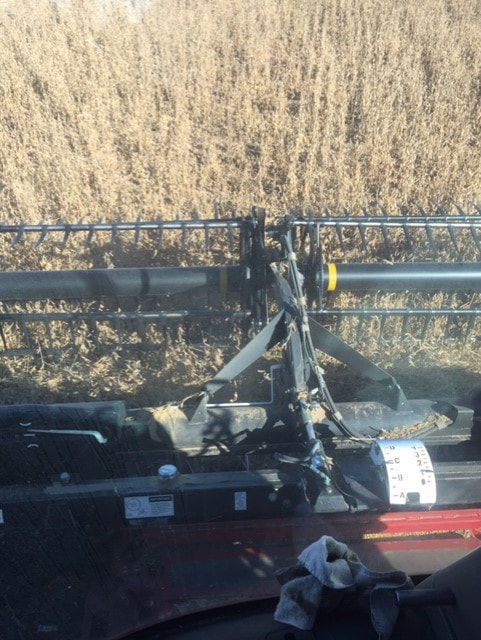
Farmers: Taproots of American Agriculture
by Heather Chamberlain
Living in an agricultural state, most Kansans would say they are familiar with the farm fields near their homes and with those they drive past daily. They can point out the wheat fields, the hay fields, corn fields, and soybean fields, but the majority of Kansas residents do not understand the land beyond this surface recognition. Farmers experience the land in a way the rest of a community does not. They live it. They breathe it in every day. They walk the land and ride it. They touch it with their hands, and they feel its potential. They smell it. It’s a work that engages all the senses. It’s a partnership, and a way of living. It’s essential to human existence, and for Mr. Doug Kohls, it is a passion for being close to the foundation of life, which inspires him to be a steward of the land.
It was a beautiful, sunny afternoon in late October when I had the privilege of meeting and spending some time with Mr. Kohls. I caught a small glimpse into his world as we drove along in a combine, harvesting soybeans in a field just north of Clearwater. I was delighted to see the wildlife: bunnies hopping through the field, a coyote lazing in the sunshine, hawks circling around, and a bald eagle that flew by right in front of us! But viewing nature on a daily basis is just one of the enjoyments of being a farmer. Through my conversation with Mr. Kohls, I learned how the farmer’s vision goes way beyond the surface. As I rode along, he showed me things I wouldn’t have otherwise noticed. He pointed out a field, just barely green, of newly sprouted wheat, and another field of freshly planted winter wheat, and a field to the south of us that was red with milo. They see the details of the land: the colors and the textures. They can look out at a distant field and know what crop is being grown, and they can see variations in the soil. I too began to see these things as my eyes were opened to the farmer’s vision.
Mr. Kohls rotates four crops in his fields: wheat, soybeans, corn, and milo. Through this rotation, he both preserves the soil and enriches it for future crops. In recent years he has adopted a no-till method of operation and has seen improvements in the soil, and he plans to continue nurturing a healthy relationship with the land. The topsoil (the good soil plants draw water and nutrients from) in South Central Kansas isn’t very deep, and wind and rain may carry it away if it isn’t carefully maintained. Mr. Kohls began no-till farming to help keep this valuable soil from eroding. Now, each harvest he leaves the residue from previous crops, the leaves and the stalks, for bacteria, worms, and other insects to decompose and return back to the earth, which helps build a nutrient-rich soil, otherwise known as humus. This is where quality produce begins.
Mr. Kohls’ products are distributed locally and across the nation, but a successful harvest begins small with the farmer nourishing the earth. The earth, when well cared for, will in turn nourish the nation. We must acknowledge and pay respect to those who labor to provide us with the essentials for life: “Soil is the life of our country,” Mr. Kohls said to me. But without the dedication of the individuals who work the soil, our country wouldn’t have very much life. It is our farmers who are the life of our country. These people find that the struggles of an agricultural lifestyle are also its greatest rewards. There is a correlation between the land and the farmer; neither can prosper without the other, and the labor of the farmer cannot be separated from the rest of his life. He consumes the same food that he grows; the same food that we also eat. Mr. Kohls’ wife occasionally bakes bread from wheat plucked straight from the field. He raised his family on this land, and it has become the heritage of his children. Mr. Kohls has four children that have all grown up to pursue some form of agricultural lifestyle for themselves, and the connection formed between himself and the land now lives on through them. The land influences the farmer just as much as the farmer influences the land: “We’re working hard to preserve this land because this is how we live, and we eat the food that comes off this land and we raise our families on it. We want our families to continue doing the same in the future, so we’re working hard every day to preserve the soil and the land to make it better.”
As we drove along in the combine, he explained to me the biological properties of farming: essentially, he told me, “what we’re harvesting is the soil and the sun.” Before parting ways, Mr. Kohls picked up a soybean plant off the ground, which had been uprooted and he showed me the taproot (the main root of the plant from which the other roots sprout from) and the nodules, which form a symbiotic relationship with the roots. Farmers aren’t just laborers; they are scientists and they are students. The care that they take in understanding the land and preserving it are foundational to a healthy nation. Farmers cultivate food, which cultivate people. The ecosystem above the soil is intimately connected with the ecosystem below, and the taproot that connects the two, and supplies the nutrients necessary for the life of the human ecosystem, is the farmer.
by Heather Chamberlain
Living in an agricultural state, most Kansans would say they are familiar with the farm fields near their homes and with those they drive past daily. They can point out the wheat fields, the hay fields, corn fields, and soybean fields, but the majority of Kansas residents do not understand the land beyond this surface recognition. Farmers experience the land in a way the rest of a community does not. They live it. They breathe it in every day. They walk the land and ride it. They touch it with their hands, and they feel its potential. They smell it. It’s a work that engages all the senses. It’s a partnership, and a way of living. It’s essential to human existence, and for Mr. Doug Kohls, it is a passion for being close to the foundation of life, which inspires him to be a steward of the land.
It was a beautiful, sunny afternoon in late October when I had the privilege of meeting and spending some time with Mr. Kohls. I caught a small glimpse into his world as we drove along in a combine, harvesting soybeans in a field just north of Clearwater. I was delighted to see the wildlife: bunnies hopping through the field, a coyote lazing in the sunshine, hawks circling around, and a bald eagle that flew by right in front of us! But viewing nature on a daily basis is just one of the enjoyments of being a farmer. Through my conversation with Mr. Kohls, I learned how the farmer’s vision goes way beyond the surface. As I rode along, he showed me things I wouldn’t have otherwise noticed. He pointed out a field, just barely green, of newly sprouted wheat, and another field of freshly planted winter wheat, and a field to the south of us that was red with milo. They see the details of the land: the colors and the textures. They can look out at a distant field and know what crop is being grown, and they can see variations in the soil. I too began to see these things as my eyes were opened to the farmer’s vision.
Mr. Kohls rotates four crops in his fields: wheat, soybeans, corn, and milo. Through this rotation, he both preserves the soil and enriches it for future crops. In recent years he has adopted a no-till method of operation and has seen improvements in the soil, and he plans to continue nurturing a healthy relationship with the land. The topsoil (the good soil plants draw water and nutrients from) in South Central Kansas isn’t very deep, and wind and rain may carry it away if it isn’t carefully maintained. Mr. Kohls began no-till farming to help keep this valuable soil from eroding. Now, each harvest he leaves the residue from previous crops, the leaves and the stalks, for bacteria, worms, and other insects to decompose and return back to the earth, which helps build a nutrient-rich soil, otherwise known as humus. This is where quality produce begins.
Mr. Kohls’ products are distributed locally and across the nation, but a successful harvest begins small with the farmer nourishing the earth. The earth, when well cared for, will in turn nourish the nation. We must acknowledge and pay respect to those who labor to provide us with the essentials for life: “Soil is the life of our country,” Mr. Kohls said to me. But without the dedication of the individuals who work the soil, our country wouldn’t have very much life. It is our farmers who are the life of our country. These people find that the struggles of an agricultural lifestyle are also its greatest rewards. There is a correlation between the land and the farmer; neither can prosper without the other, and the labor of the farmer cannot be separated from the rest of his life. He consumes the same food that he grows; the same food that we also eat. Mr. Kohls’ wife occasionally bakes bread from wheat plucked straight from the field. He raised his family on this land, and it has become the heritage of his children. Mr. Kohls has four children that have all grown up to pursue some form of agricultural lifestyle for themselves, and the connection formed between himself and the land now lives on through them. The land influences the farmer just as much as the farmer influences the land: “We’re working hard to preserve this land because this is how we live, and we eat the food that comes off this land and we raise our families on it. We want our families to continue doing the same in the future, so we’re working hard every day to preserve the soil and the land to make it better.”
As we drove along in the combine, he explained to me the biological properties of farming: essentially, he told me, “what we’re harvesting is the soil and the sun.” Before parting ways, Mr. Kohls picked up a soybean plant off the ground, which had been uprooted and he showed me the taproot (the main root of the plant from which the other roots sprout from) and the nodules, which form a symbiotic relationship with the roots. Farmers aren’t just laborers; they are scientists and they are students. The care that they take in understanding the land and preserving it are foundational to a healthy nation. Farmers cultivate food, which cultivate people. The ecosystem above the soil is intimately connected with the ecosystem below, and the taproot that connects the two, and supplies the nutrients necessary for the life of the human ecosystem, is the farmer.


